|
| |
Back to Trainers
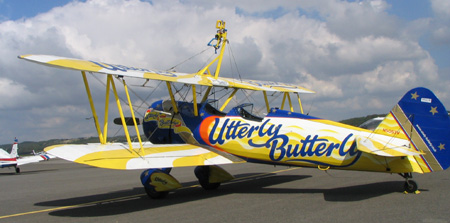 |
Lloyd Stearman was a partner with Walter
Beech and Clyde Cessna in the pre-war Travel Air company. When he
left and formed his own company, one of his first products was this
robust, safe but extremely agile biplane, which became the standard
basic trainer for the US armed forces. Universally known simply as a
`Stearman', it is more properly known as the Stearman A75, or later
as the Boeing-Stearman Kaydet after the Stearman company was
acquired by Boeing shortly before the war. It bore several US
military designations: the basic PT-13, with 200hp Lycoming R-680
engine; PT-17, with 220hp Continental R-670 engine; PT-18, with
225hp Jacobs R-755 engine; PT-27, for PT-17s built in Canada; and
N2S, for any of the above in service with the Navy rather than the
Army Air Force. All had a length of 24 feet 3 inches, wing span of
32 feet 2 inches, top speed of around 105mph, range of about 470
miles and gross weight of 2,700 lb. The model 75 first flew in 1936.
Over 10,300 of all variants were built.
Many are still in use, including this one seen at Le Touquet in
September 2005. The pylon on the upper wing is a harness for a
wing-walker; it is one of two similarly equipped Stearmen which
regularly perform wing-walking aerobatic displays at air shows
throughout Britain and northern Europe. |
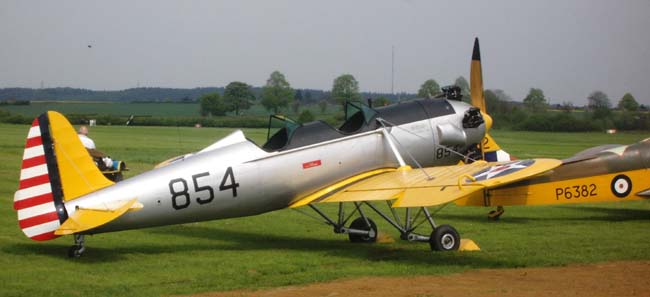 |
Claude Ryan's name in aviation had been made
by his stylish M-1 mailplane and the `Spirit of St Louis', in which
Charles Lindbergh became the first man to fly solo across the
Atlantic. The Ryan ST (`Sports Trainer') first flew in 1939, and was
adopted by the US Army Air Force as its first ever monoplane
trainer, named the Ryan Recruit. It was lighter (1,860lb) and faster
(130 mph) than the Stearman, though similarly sized (22 feet 5
inches long, 30 feet one inch wing span). Range was 350 miles. It
too went through many military designation: the original PT-16 had a
120hp Menasco inline engine; the PT-20 had a Kinner R-440 radial;
the PT-21 was a developed version of the PT-20; the PT-22 had a more
powerful 160hp Kinner R-540. The PT-25, powered by a 185hp Lycoming
engine, was built entirely of wood to save strategic materials
during the war. The NR was any of the above serving with the US
Navy. All told, 1,273 Recruits were built.
The PT-21 is airworthy in the UK and is pictured
at Old Warden in Summer 2005. |
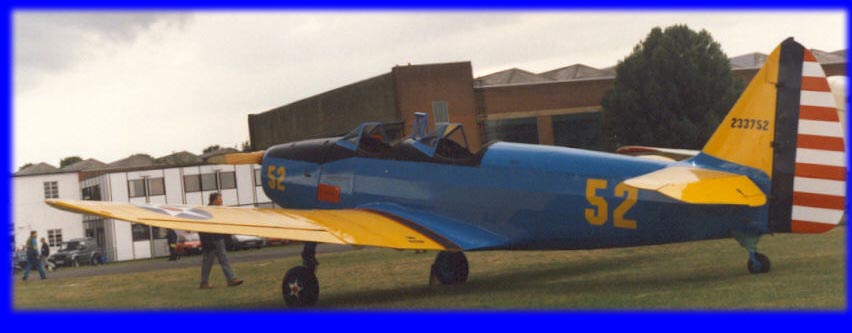 |
The Fairchild PT-19 Cornell was a larger
(2,730lb; 27 feet 8 inches long; 36 feet wing span) trainer than the
light Ryan Recruit, and served in larger numbers (11,745 of all
models were built). Speed, at 125mph, was similar, and range (400
miles) a bit more. Its three military designations were PT-19 (175hp
Ranger inline engine), PT-23 (220hp Continental R-670 radial) and
PT-26 (200hp Ranger inline, built in Canada).
This PT-19 was at Cranfield in 1996. |

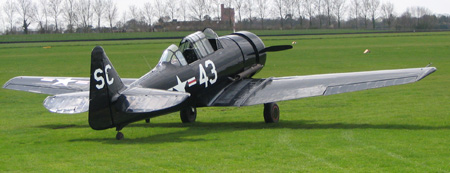 |
The North American AT-6 Harvard
(Texan) advanced trainer is probably the trainer built in the
largest numbers (21,342, including Navy SNJs and Canadian built
Noorduyn AT-16s) of any training aircraft in history. It is also the
only aircraft I can recognise within a second of hearing it by sound
alone: the unique gearing of the 600hp Pratt & Whitney R-1340 engine
makes the propeller tips go faster than the speed of sound, giving a
characteristic crackling whine. First flown in 1935, it is a big (29
feet 6 inches long, 42 feet wing span) and heavy (5,300lb gross
weight) aircraft, with excellent handling characteristics. Maximum
speed is 208mph and range is 750 miles. There were some interesting
derivatives: the BT-14 Yale was a simplified version with fixed
undercarriage and a smaller engine; 41 examples of an attack
version, the A-27, were built; and 13 were built as a fighter
version, the P-64. Top: AT-6A was at a
gathering of European Harvards at Bassingbourn in May 1978. Lower:
Harvard at Goodwood, April 2006. |
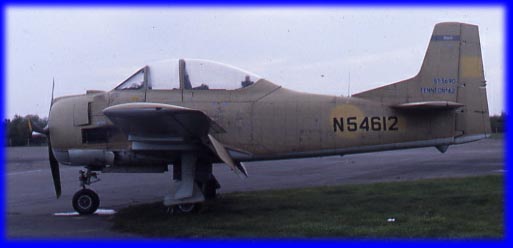 |
The North American T-28 Trojan was designed
as a post-war advanced trainer successor to the Harvard. It is a
powerful machine, equipped with a 1,425hp Wright R-1820 Cyclone
engine. Length is 33 feet and wing span 40 feet. Gross weight is
7,880lb, top speed 345mph, and range 1,000 miles. It first flew in
September 1949. Service life was relatively short, because its role
was adopted by the new generation of jet trainers. Nevertheless,
2,230 were built, including several under license by Sud Aviation in
France as the Fennec. This Fennec was at
Blackbushe in September 1978. |
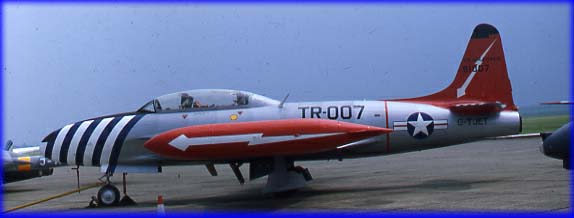 |
The Lockheed T-33 was essentially a two seat
trainer development of the famous P-80 Shooting Star, America's
second jet fighter after the unsuccessful Bell P-59 Airacomet, which
flew just too late to see service in the second world war. The T-33
first flew in March 1948, and proved a superb jet trainer; it
remained in service with several air forces into the 1990s. It is
powered by a single Allison J-33 turbojet of 5200lb thrust, giving
it a top speed of 600mph and range of 1,345 miles. Gross weight is
14,442lb; wing span 38 feet 10 inches; and length 37 feet 9 inches.
All told, 5,691 were built. This one was
at Duxford in June 1984. |
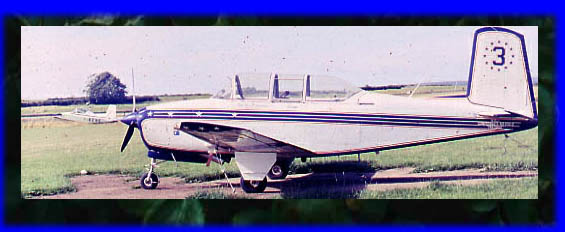 |
The Beech T-34 Mentor (company designation
Beech 45) was a tandem trainer developed using the wings and dynamic
systems of the famous Bonanza. It first flew in 1948. Powered by a
225hp Continental piston engine, its top speed was 188mph, and range
was 770 miles. Gross weight was 2,900lb; length, 25 feet 10 inches;
wing span, 32 feet 10 inches. 1,300 were built. Several were later
converted to turboprop power. Many have now found their way to
civilian operators. This T-34 was at
Thruxton in July 1978 (with apologies for the deteriorating slide!) |
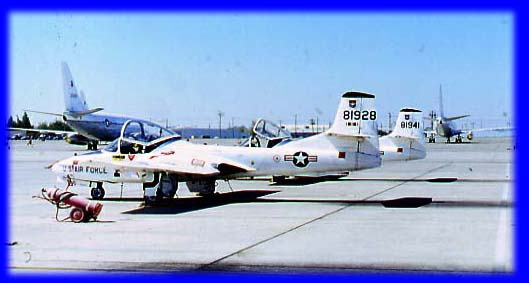 |
The Cessna T-37 was developed as a dedicated
jet trainer for the US Air Force. For safety, it was powered by two
Continental J-69 turbojets, each of 1,025lb thrust. This gave it a
top speed of 410mph and range of 650 miles. It first flew in October
1954. As a basic trainer, it is much smaller (28 feet 3 inches long,
35 feet 10 inches wing span) and lighter (6,580lb gross weight) than
the advanced trainer T-33. 1,300 were built; in addition, 580 were
built as the A-37 Dragonfly, a ground attack version which could be
equipped with a variety of armament on underwing stores points.
These T-37Bs were at Mather in September 1981. |
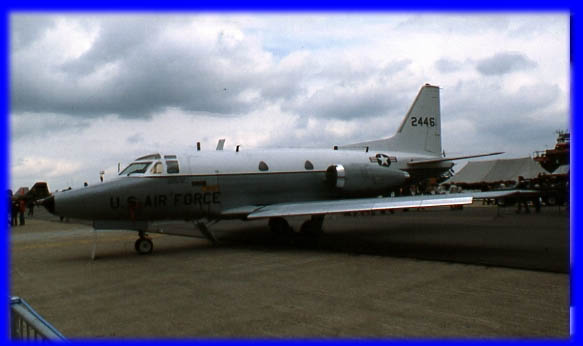 |
The North American (Rockwell) T-39 Sabreliner
was originally developed as a navigation and aircrew training
aircraft for the US Air Force, and for the US Navy as the T3J. With
a normal complement of 9 people, it was also ideal as an executive
transport; the CT-39 version was built specifically for this role.
Later, the design was developed for the civil business jet market,
and found significant success, mainly in the US. Its two 3,000lb
thrust Pratt & Whitney J60 turbojets give it a top speed of 500mph
and range of 1,950 miles. Gross weight is 17,760lb; length, 43 feet
8 inches; wing span, 44 feet 4 inches. It first flew in September
1958. About 600 of all versions, military and civil, were made. Note
the unusual pear-shaped windows. This
CT-39A was at Greenham Common in June 1979. |
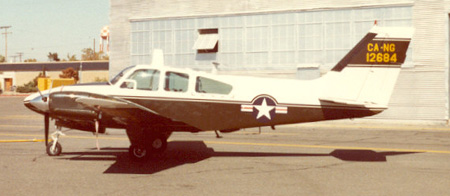 |
The Beech T-42 Cochise is a military version
of the B-55 Baron, used as an instrument trainer and light liaison
aircraft. It has the same two 260hp Continental IO-520 engines,
giving it a top speed of 200mph and range of 920 miles. it first
flew in 1965; 65 were built. This one
was at Mather in
September 1981. |
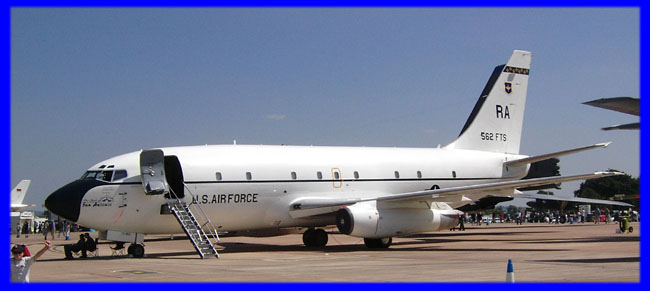 |
The Boeing T-43A is a designation used for
nineteen Boeing 737s bought by the US Air Force in 1972 for use as
navigation trainers. They are readily told from their civil
counterparts by the irregular pattern of windows - though the `US
Air Force' markings are a bit of a giveaway, too. They are still in
service in 2005.
This one was at
Fairford in July 2005 |
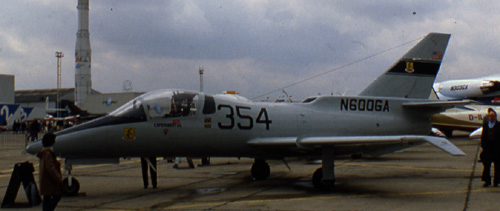 |
The Grumman NGT was a one off private venture
trainer, designed for a USAF New generation Trainer contest which
the Air Force abandoned in favour of the JPATS contest (which was
won by the Pilatus PC-9). It used the same platform as the Peregrine
single engined business jet. Only one was built; it crashed in late
1983 and was not replaced.
It was pictured at
Paris in May 1983. |
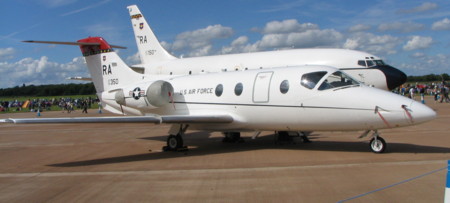 |
Beech T1A Jayhawk
Fairford, July 2007 |





|